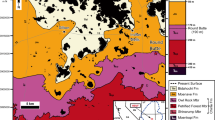Abstract
Lithic fragments in the ground layer of the Ata pyroclastic flow deposit, southwestern Japan, were supplied from two different sources. One is the eruptive vent and the other is the basement rock exposed underneath the path of flow. Lithic fragments captured at the eruptive vent gradually decrease in size with distance from the source. Local increases of ML or Md are proportional to increased amounts of captured lithic fragments. The pyroclastic flow eroded basement formations on slopes dipping away from the source, and deposited the lithics within the ground layer on slopes dipping towards the source. The ground layer was found only in the western half of the Ata pyroclastic flow deposit. The absence of the ground layer in the eastern half of the pyroclastic flow deposit is interpreted to result from a selective loss of lithics when the flow traversed a bay or a lake located just east from the vent.
Similar content being viewed by others
References
Aramaki S, Ui T (1966) Aira and Ata pyroclastic flows and related caldera depressions in southern Kyushu, Japan. Bull Volcanol 29:29–48
Hayasaka S (1982) Kagoshima Bay as a graben structure. In: Y Matsumoto (ed) Reports on the basement formations and graben structures in Kyushu 1:76–78 (in Japanese)
Hildreth W, Mahood GA (1986) Ring-fracture eruption of the Bishop Tuff. Geol Soc Am Bull 97:396–403
Machida H (1984) The significance of explosive volcanism in the prehistory of Japan. Geol Surv Japan Rep 263:301–313
Ono K, Matsumoto Y, Miyahisa M, Teraoka Y, Kambe N (1977) Geology of the Taketa district. Geol Surv Japan: pp 1–145 (in Japanese with English abstract)
Ono K, Watanabe K (1983) The Aso-4 pyroclastic flow has traversed the sea. Abstract for annual meeting of Geol Soc Japan:307 (in Japanese)
Potter DB, Oberthal CM (1987) Vent sites and flow directions of the Otowi ash flows (lower Bandelier Tuff), New Mexico. Geol Soc Am Bull 98:66–76
Sakaguchi K (1980) The Tashiro pyroclastic flow deposit, Ohsumi Peninsula, Japan. Master thesis of Kobe University: pp 1–42 (in Japanese with English abstract)
Sakaguchi K, Ui T (1983) Capture of lithic fragments during flowage of a pyroclastic flow — a case study in the Tashiro pyroclastic flow, southern Kyushu, Japan. Bull Volcanol Soc Japan 2nd ser 28:317–320 (in Japanese)
Sparks RSJ, Self S, Walker GPL (1973) Products of ignimbrite eruptions Geology 1:115–118
Suzuki K (1983) Flow and emplacement mechanisms of a large-scale pyroclastic flow. Ph. D. Thesis Kobe University: pp 1–193
Suzuki K, Ui T (1983) Factors governing the flow lineation of a large-scale pyroclastic flow — An example in the Ata pyroclastic flow deposit, Japan. Bull Volcanol 46:71–81
Ui T, Metsugi H, Suzuki K, Walker GPL (1983) Flow lineations of Koya low aspect-ratio ignimbrite, south Kyushu, Japan. EOS 64:45
Walker GPL (1983) Ignimbrite types and ignimbrite problems. J Volcanol Geotherm Res 17:65–88
Walker GPL, Self S, Froggatt PC (1981) The ground layer of the Taupo ignimbrite: A striking example of sedimentation from a pyroclastic flow. J Volcanol Geotherm Res 10:1–11
Watanabe K (1985) Ata pyroclastic flow deposit in the Hitoyoshi Basin, Kumamoto Prefecture, Japan. Mem Fac Education Kumamoto University Natural Science 34:55–62 (in Japanese)
Wilson CJN (1980) The role of fluidization in the emplacement of pyroclastic flows: an experimental approach. J Volcanol Geotherm Res 8:231–249
Wilson CJN (1984) The role of fluidization in the emplacement of pyroclastic flows, 2: Experimental results and their interpretation. J Volcanol Geotherm Res 20:55–84
Author information
Authors and Affiliations
Rights and permissions
About this article
Cite this article
Suzuki-Kamata, K. The ground layer of Ata pyroclastic flow deposit, southwestern Japan — evidence for the capture of lithic fragments. Bull Volcanol 50, 119–129 (1988). https://doi.org/10.1007/BF01275173
Received:
Accepted:
Issue Date:
DOI: https://doi.org/10.1007/BF01275173




